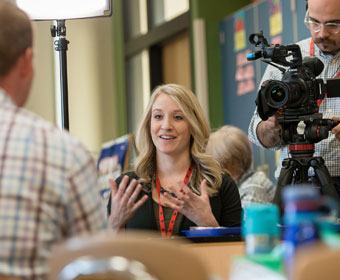District leaders – I’m sorry. Most people don’t care about your new strategic plan as much as you do. However, your community does care about the impact that plan is having inside classrooms.
So, instead of telling people about your new strategic plan, how about showing them the impact the plan is making through stories.
Schools have some of the most powerful stories of perseverance, triumph and overcoming incredible odds. However, these stories that have the power to bolster community support and change perceptions toward schools often go untold.
Putting together good stories takes time. It’s easier to have someone sit in the comfort of the district office and write about all of the new opportunities students will have because of the strategic plan than going through the steps of telling a good story.
Watch a free webinar video on-demand: Show vs. Tell: Using Video to Engage your School Community
Video has an unfair advantage over other communication tactics when it comes to storytelling. With video you are able to show rather than just tell a story. You can see, hear and feel the impact a person or program has had on the life of a student or teacher.
Here are six tips to keep in mind as you start crafting stories for your school or district.
1. Do your research.
The first story that is presented to you may not be the best story to tell. Talk to teachers, secretaries or principals and tell them the type of story you are looking to tell. They typically have a good pulse on what’s going on. You’ll want to have conversations with the student and their family to make sure they are comfortable with being featured in a story.
2. Pinpoint the purpose.
Think about your “why”. Why is this something you want others to know? What do you want them to know? What emotion do you want them to feel? Purpose is the impact you want your story to have on your audience. People get lost in stories that don’t have a well-defined purpose. Do your audience and the person telling the story a favor - have one clear vision as you put things together. You don’t want to invest a lot of time into telling a great story that moves people, but have nothing happen as a result.
Purpose also brings clarity and focus. Many people think they need to find a story that will highlight all 17 bullet points from strategy #1 in the strategic plan. Keep your focus on the story. If people really want to know all 17 bullet points, they can visit your website or download the PDF. A good story should include some of those bullet points in an authentic way, but don’t try and cram all 17 into your story.
3. Find your characters.
People connect with other people. Often times the story should focus on a person, not a program. Instead of talking broadly about a new initiative that is providing additional mental health resources, find one student whose life has changed because of the new resources. You’ll want to identify “helpers”, like teachers, coaches or parents to assist in telling the story of your main character. Many times the main character has blind spots they cannot see and need to have others help them out. When stories fail to resonate with the audience, it’s often due to weak characters.
4. Determine the conflict.
The word conflict can have a negative connotation in schools. We may think of a fight or some sort of crisis situation. But a conflict or challenge is a necessary ingredient in a great story. Think of any great movie. There is some sort of conflict the main character has to overcome. If Simba simply became the Lion King without having to fight his uncle Scar, it really wouldn’t have been a story. Conflict brings people into the story and makes them more emotionally invested.
Rather than giving people the answer and telling them what to think, a story can take us on a journey where you come to your own conclusions. And when the idea is yours, it's far more trusted.
5. Show the resolution.
After the conflict has been presented, there needs to be some sort of resolution. What happens now that Simba has defeated his uncle? Show the progress your main character has made. They have been on a journey up to this point and your job as a storyteller is to bring closure. Remember your original purpose of telling the story. Make sure you end with your audience knowing what kind of action you want them to take.
6. Share your story.
Once you’re done putting the story together, you need to get it in front of the right audiences. Sharing the video on your website and social media channels is pretty standard. Spend some time researching hashtags or other like-minded organizations who could help share and increase your reach.
Think beyond video as well. If you’ve already conducted all of the interviews, you have the content to re-purpose the story for print. You can also use still images from the video with a powerful quote to help reinforce key messages from the story. If you really want to take things to the next level, take some of the interview audio and include that in a podcast.
I’m not going to sugarcoat it, telling a story is a lot of work. It’s much easier to just write something sitting in a chair at the district office. If your goal is to move hearts and minds, stories are the way to go. People are starving for joy and you can help by providing uplifting and inspirational stories from your district. People are already telling stories about your schools and district, why not equip them with the stories you want shared and repeated?
Start changing your narrative and build your brand while inspiring people in your community. Begin by showing and telling stories that resonate with your audiences. If this sounds like too much work, me and my team are always looking for opportunities to help districts and schools tell better stories.
Related articles:
Great Content to Put on Your School Youtube Channel
How to Go Live with Live Streaming School Video
Topics: Marketing Communication Branding

About the author
A champion video storyteller and APR professional, Jake Sturgis worked for more than a decade in school districts before starting his own business in 2014. As founder of Captivate Media + Consultants, his focus has been on helping schools and non-profits use video to help tell their stories. Reach him at jake@captivatemedia.us.
.png?width=64&height=63&name=Group%20(4).png)
.png?width=66&height=64&name=Group%20(5).png)
.png?width=56&height=60&name=Group%20(6).png)
.png?width=66&height=52&name=Group%20(7).png)
.png?width=56&height=56&name=Group%20(9).png)
.png?width=59&height=52&name=Group%20(10).png)


